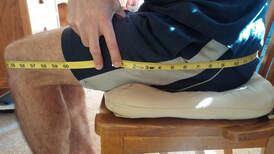Length – I generally recommend sizing sleep system length close to your total height or a couple inches longer. This leaves room for the top to cinch around your neck, allows for stomach sleepers to point their toes, prevents your toes from pushing into the loft at the footbox, and eliminates the likelihood of tension pulling on the shells.
For sizing False Bottom Bags like the Wren, you will want to take a few measurements. The listed circumferences and widths for each system are taken at thirds along the length. Top / Torso / Knee / Foot.
Shoulders – the top of the bag needs to be large enough for you to get in, so you generally want the top to have a circumference at least as large as the circumference around your shoulders at the widest point. You can go with that if you’re looking to be SUL and/or that is all you need, but if you want a little extra room for easy entry/exit or whatever, I usually recommend adding 5″
Torso – The “fetal position” systems are meant to be sized large enough to curl up in fetal position inside of. This is an extremely efficient position to use for warmth retention. By curling up and pulling the footbox in, I can take a sleep system well below it’s rating. Even if y ou can’t sleep this way, it’s a handy feature to use for warming up prior to stretching out. The side benefits to this sizing are that you can also lay with one leg straight out and one leg up, to the side too. I also use that wide torso girth to sit indian style/cross legged to warm my feet up before bed. To measure for this, sit in a chair with thighs horizontal and knees together. Measure from the front of knees, down one thigh, around butt, up other thigh, and back to knees. Add an inch or two and this should give you a number that is large enough for your knees to pull up.
ou can’t sleep this way, it’s a handy feature to use for warming up prior to stretching out. The side benefits to this sizing are that you can also lay with one leg straight out and one leg up, to the side too. I also use that wide torso girth to sit indian style/cross legged to warm my feet up before bed. To measure for this, sit in a chair with thighs horizontal and knees together. Measure from the front of knees, down one thigh, around butt, up other thigh, and back to knees. Add an inch or two and this should give you a number that is large enough for your knees to pull up.
The “mummy shape” systems are meant to be sized more like a traditional mummy type sleeping bag where the bag bends with your legs instead your legs curling up inside of the bag. If you don’t ever use full fetal position and are more likely to keep your legs together and just bend your knees a little, these systems will be more efficient. To measure the required torso area circumference for these systems you can simply loop a tape measure around your torso with room for your arms at your sides. Estimate the amount of room you need here.
Knee – This is less about a physical measurement around your knees than it is about estimating the amount of room you need to move here. The footbox is an area where you want to find a balance of efficiency vs comfort. Too much room means you’re building in a a lot of surface area to loose heat through, in a spot where you want efficient insulation around your extremities. Too little room and you won’t be able to move your legs and the whole system will want to spin with you when you roll. Run a tape measure around your knees to find out how much room is comfortable for you. Note that with the custom sizing option, you can stipulate a tapered footbox instead of the preset straight footbox.
Foot – To size the round foot end of the system, measure the length of your foot. Multiply that number by 3.14 and that will give you the circumference you need here. It is possible to get away with less since the circle can be elongated, but this is a safe starting point.